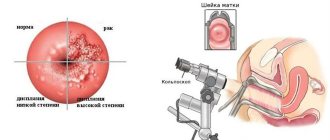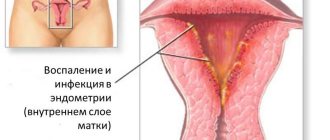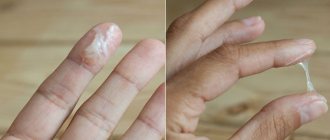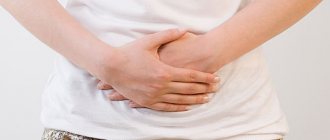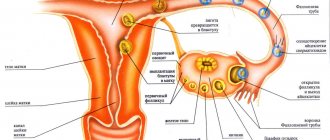When the lower abdomen hurts and discharge occurs
The occurrence of pain in the lower abdomen and discharge of various types in women can occur for a number of reasons.
Some of them are a natural process occurring in the body, others are evidence of pathology. And if only pain is present, and the discharge remains within the physiological norm, we can talk about diseases not related to the reproductive system. If the discharge becomes unnatural (changes its character and causes suspicion), and the painful sensations intensify, there is a reason to immediately contact a antenatal clinic to find out the cause of this phenomenon.
Note! This is not a horror story, but a real picture of what the appearance of unusual discharge and pain in the lower abdomen may indicate.
Menstrual cycle
Each woman's menstrual cycle is individual. It can range from 21 to 28 days (in some cases a little more, but not much). Such indicators are considered the norm.
The duration of menstruation can also vary from 3 to 7-8 days, which is also not a pathology. Many women experience nagging pain in the lower abdomen a day or two before the onset of their period. A mucous-bloody discharge appears, quite scanty and in most cases odorless.
On the due day, menstruation begins, and the discharge becomes completely bloody, with only a small amount of mucous secretion. This is the tearing away of the productive layer of the endometrium, which was preparing to receive a fertilized egg. And since conception did not occur, its further presence in the uterus is unjustified. After all, in the next cycle the process will repeat again.
Painful sensations of aching and pulling nature can be observed a couple of days before and the first day or two after the onset of menstruation. They can be of varying intensity - from causing mild discomfort to very strong, literally interfering with a normal life.
Naturally, intense pain is relieved with painkillers. But in this situation, you should definitely contact a specialist and find out whether this is a physiological norm (this happens, and there’s nothing you can do about it, you’ll have to live with it somehow!) or a pathology that needs to be treated with adequate means.
Note! Teenage girls who have not yet begun to be sexually active or women who have not given birth may develop such intense pain in the lower abdomen that accompanies all periods, from the first to the last day, that in some cases they provoke loss of consciousness. And often it is not possible to find out the cause of this phenomenon even when using all possible modern diagnostic methods.
Ovulation
Pain in the lower abdomen and discharge during ovulation are considered normal. However, there are characteristic symptoms for the physiological process of the release of an egg from the ovary;
- discomfort sensations are cramping, stabbing or cutting in nature. The pain will be in the lower part on the side of the egg-producing ovary;
- the duration is usually an hour or two, but in some cases it can last up to two days;
- The discharge is mucous, whitish in color, reminiscent of egg white. The consistency is more liquid than on other days of the cycle;
- a small admixture of blood in the form of small lumps or thin veins is possible.
The secretory fluid released during ovulation is more abundant and this condition can last on average about 2-3 days.
If the painful sensations are tolerable and do not cause much discomfort, do not require medication and are regular in this form, then there is nothing to worry about.
Note! If the pain becomes too severe, painkillers help only for a short time, and discharge, like snot, and even mixed with something incomprehensible, is an alarming signal. Such symptoms may indicate the presence of serious pathological processes in the body and qualified help is needed to eliminate them.
What other reasons are there why the lower abdomen hurts and the secretory fluid secreted is significantly different from the norm?
source
Adnexit
Adnexitis or inflammation of the appendages is a disease manifested by pain of quite high intensity. The discharge may be bloody, clear or whitish. Such manifestations will be mild in the case of a chronic process. The causative agent of the inflammatory process can also affect the intensity of the clinical picture.
Symptoms are conventionally divided into two categories: local and general.
Local manifestations indicate the degree of damage to the organ or both and the degree of preservation of functionality:
- pulls the lower abdomen with a “return” to the lower back or hip joint. Pain intensifies during sex and during menstruation;
- discharge is bloody and profuse. Mucopurulent or serous, with an unpleasant odor;
- aching chest with localization of more severe pain in the nipples.
General signs of the disease are not much different from the manifestation of an inflammatory process involving the entire body and the appearance of intoxication:
- chills accompanying an increase in temperature, sometimes up to 39°C;
- muscle and joint pain;
- symptoms of general intoxication: headaches, dizziness, nausea and vomiting.
Note! Treatment should be immediate so as not to provoke complications that affect the condition of the entire reproductive system.
Why does the lower abdomen pull like during menstruation?
When there is pain in the lower abdomen and the appearance of white discharge is noticeable, we can talk about the presence of a disease. Normally, the appearance of transparent or slightly light-colored discharge is allowed - this is a normal physiological process. Aching pain, white discharge instead of menstruation not only reduce the quality of life, but also possibly threaten a woman’s health, so this phenomenon should be combated. In cases where the lower abdomen hurts after menstruation or if pathological smears appear a few weeks before menstruation, you should contact an antenatal clinic, where experienced doctors will help treat such symptoms and find out their causes.
Ovulation
Every representative of the fairer sex should have information about the beginning of ovulation, especially those who dream of having a child.
You can determine ovulation by paying attention to vaginal mucous discharge - its composition, consistency, quantity.
At the first stage of the menstrual cycle, the consistency of the mucus is viscous, thanks to it the uterus is protected from harmful microbes. Before ovulation, it changes composition, becomes more liquid, due to which it can come out.
In the middle of the cycle, the smears look like the white of a raw egg. This mucus indicates the onset of ovulation. After this stage is completed, the discharge becomes sticky again.
The appearance of clear, odorless discharge is most often normal; you should be concerned if, after ovulation, white cheesy masses appear, accompanied by itching, inflammation on the labia, they indicate the appearance of thrush. Such masses have an unpleasant sour smell and are not the norm; they need to be dealt with.
Gynecological diseases
White discharge may indicate the presence of a serious gynecological disease. The cause may be inflammation or infection with worms, allergies, hormonal disorders, etc.
The most common pathologies, one of the symptoms of which is white mucus:
- Vulvitis is inflammation of the external genitalia. Can be acute or chronic. Symptoms: purulent discharge and pain in the lower abdomen, itching, fever, enlarged lymph nodes. For diagnosis, blood tests, urine tests, cultures, and smears to study microflora are prescribed.
- Colpitis is an inflammatory process of the vaginal mucosa. Symptoms: pain in the lower abdomen, profuse leucorrhoea either with pus or a grayish tint, burning sensation, discomfort when urinating. To carry out diagnostics, the doctor examines the pelvic organs, taking blood, urine, and vaginal discharge tests.
- Chlamydia is an infectious disease that affects the external and internal genital organs of a woman. Symptoms: fever, pain in the lower abdomen and discharge that has an unpleasant odor.
- Gonorrhea is a disease caused by gonococcus. Symptoms: fever, possible delay of menstruation and white discharge, which turns green as the disease progresses. Treatment should be carried out at the first symptoms.
- Bacterial vaginosis is one of the causes of the formation of white discharge with an unpleasant smell of rotten fish. Symptoms: itching (may be absent), unpleasant odor, which intensifies upon contact with soap or other cleaning cosmetics. This unpleasant disease occurs mainly in women of reproductive age. If it is not treated promptly, serious complications may occur.
Thrush
Candidiasis manifests itself in white discharge masses with the presence of clots. This disease is fungal and can affect large areas if left untreated.
The fungus that causes thrush is found in all women's bodies, and only its uncontrolled increase can lead to such a disease.
The main symptoms of thrush:
- Itching, burning.
- Swelling, redness of the mucous membranes.
- Lack of sleep due to discomfort in the intimate area.
- Unpleasant sensations when urinating.
- Leucorrhoea has a specific smell of sour milk.
After examination by a doctor and removal of the white film, erosions, redness, and bleeding cracks can be seen.
Causes contributing to the occurrence of candidiasis:
- Decreased immune system function.
- History of chronic diseases.
- Hormonal pathologies.
- Long course of antibiotic treatment.
- Use of contraceptives.
- Excess weight.
- Problems with the gastrointestinal tract.
- Eating fatty, salty, sweet, spicy foods in large quantities.
- Neglect of hygiene or excessive treatment of the intimate part of the body with alkaline soap and other means.
- Change of sexual partners.
- Drinking large amounts of caffeine.
Thrush can cause various complications. It can affect the cervix, the urinary canal, and the development of infertility is possible if there is a history of sexually transmitted diseases.
The disease can be diagnosed using colposcopy, examination of vaginal smears and bacterial culture.
Pregnancy
A delay in menstruation worries any woman, because if there is no menstruation, pregnancy or health problems are possible.
If menstruation is delayed by 3 days - 6 days, we can talk about a delay, which should worry the girl.
First you need to rule out pregnancy; just do a test, which is sold in any pharmacy. But we should not forget that the result may be false, and if your period does not come, you need to go to the gynecologist.
Possible reasons for the delay may be stress, acclimatization, or previous colds or flu.
However, leucorrhoea often appears in the first trimester of pregnancy. They can be normal and pathological.
Options for a normal pregnancy:
- Mucus produced as a result of hormone changes. It is white, odorless, and does not cause discomfort.
- Transparent mucus resulting from the formation of a plug that protects the fetus from infection.
Pathological mucus, which should not normally be present:
- The appearance of blood can threaten the life and health of the woman and fetus.
- Smears may indicate an ectopic pregnancy.
- Yellow mucus indicates a possible infection.
In this case, you must immediately contact the antenatal clinic for an appointment.
After sex
Usually, mucus after sexual intercourse in a woman is normal and represents a natural protection of the genital organs from possible damage. In a healthy woman, such leucorrhoea should not have any shades or inclusions; it is either transparent or whitish, odorless.
If there are blood clots, injuries during sex, inflammation or erosion may occur. In the case of pathologies, such discharge may be accompanied by pain.
What diseases have symptoms of heavy discharge:
- Thrush - white smears after sexual intercourse with a sour odor.
- Gardnerellosis - grayish or white smears with an unpleasant odor of rotten fish, accompanied by discomfort during sex.
- Vaginitis is accompanied by an unpleasant fishy odor from the vagina.
- Chlamydia is a sexually transmitted disease, accompanied by a yellow discharge mixed with pus.
If you experience pain during sexual intercourse, discharge of varying consistency, accompanied by pain in the chest, abdomen, lower back, or unpleasant odor, you should consult a doctor.
Types of pain
Pain that occurs in the lower abdomen of women is divided into several types:
- sharp, cutting;
- dull;
- cramping;
- incessant;
- pulsating.
During the initial examination, doctors focus on the location of pain and the intensity of its manifestation.
Based on the characteristics of pain and presenting symptoms, a specific disease can be diagnosed.
Table 1. Symptoms and possible diseases
| Symptoms | Most likely disease |
| Dull pain accompanied by bloody discharge unrelated to menstruation | Inflammatory process of the genitourinary system |
| Prolonged pain, intense vaginal discharge and increased body temperature | Infectious diseases of the pelvic organs |
| Constant pain due to urinary problems | Urinary tract diseases |
| Cramping pain alternating with vomiting and lack of appetite | Pathologies of the gastrointestinal tract |
| Periodically increasing pain lasting a long period of time and fever | Inflammation of the appendix |
Dysmenorrhea
Premenstrual syndrome is expressed through migraine attacks, nervousness, mood swings, weakness and pain in the lower abdomen. Manifestations of this kind both precede and accompany menstruation. These days, the stomach may increase in volume. If there is excessive production of a hormone that causes uterine contractions, the intensity of the pain increases.
Dysmenorrhea often causes heaviness in the lower abdomen
In nulliparous women, dysmenorrhea is considered primary. After the baby is born, the discomfort goes away and the cycle stabilizes. Representatives of the fair sex who have reached the age of 30 experience secondary dysmenorrhea. It is triggered by disruptions in the functioning of the uterus, operations or the formation of tumors.
Means to reduce heaviness in the lower abdomen in women
Since dysmenorrhea is a natural process occurring in the body, you can try to relieve the discomfort yourself. It is quite problematic to completely relieve the pain syndrome. It seems possible only to take measures aimed at reducing it. Folk remedies and special exercises successfully cope with this task.
A decoction of St. John's wort is an excellent remedy for heaviness and pain in the lower abdomen.
The following herbal decoctions will help cope with pain:
- Crushed leaves of St. John's wort, calendula and chamomile flowers brewed in equal parts.
- Dried dandelion roots, soaked for 20 minutes in a water bath.
- Pharmacy tincture of calendula.
- Green tea flavored with a pinch of mint and lavender.
- A collection of chamomile, mantle, rose petals, calendula and nettle.
- A mixture of oak bark and valerian.
Decoctions should be taken 3 times a day before meals. Herbs should be brewed at the rate of 20 g. for 1 glass of boiled water. Taking B vitamins, zinc, magnesium and calcium is also beneficial during this period.
In addition to traditional medicine, it is useful to do physical exercises aimed at improving the condition.
A combination of the following exercises provides significant pain relief:
- From a kneeling position, with your hands on the floor, rotate your pelvis in different directions. Recommended execution time is 5 to 7 minutes.
- Sitting on the mat, straighten your back and touch your heels. From this position, you need to try to raise your legs to your stomach about 25 times in a fast rhythm.
These simple movements help improve blood flow in the internal organs and reduce discomfort. If you have severe pain, you should visit a gynecologist.
Signs of disease or normal condition
Vaginal leucorrhoea in any woman is a natural physiological process. Normally, they should not have a color other than white, be uniform and of medium volume. Their complete absence, or too many of them, is a sign of a pathological condition.
Symptoms such as itching, burning, odor, pain not only reduce the girl’s quality of life, causing multiple inconveniences, but can cause serious harm to the body.
Complications of pathologies can be avoided by starting therapy on time. By consulting and listening to an experienced doctor, there is a chance to get rid of unpleasant diseases forever and avoid health problems in the future.
source
When should you see a doctor?
Contacting a specialist is necessary when leucorrhoea is of a recurring nature and is accompanied by itching, burning and other unpleasant symptoms.
Too much mucus during the day is also abnormal.
Systematic discharge may also be a sign of an allergic reaction or incorrectly prescribed hormonal therapy. Only a doctor can accurately determine the presence of pathology and diseases.
Useful articles on the topic: Green discharge in women Yellow discharge in women HIV symptoms in women
This article has been verified by Olga Zorina, a current qualified physician, and can be considered a reliable source of information for site users.
Rate how helpful this article was
42 people voted
average rating 4.8
“Burning, itching and white discharge - the main causes and treatment regimens”
2 comments
Vaginal discharge is a topic that women are embarrassed to talk about openly. Many of them resort to the Internet to find out how to treat discharge and itching at home. However, such tactics are not always justified: true information is posted only on medical websites (not on forms!), the knowledge gained will help to figure out whether everything is okay with the female body and suggest the cause of painful symptoms. In any case, a reliable diagnosis can only be made by a qualified gynecologist after conducting a series of examinations.
Vaginal discharge: normal and abnormal
Discoloration and itching are a sign of infection
A healthy woman always has discharge, transparent or whitish. The volume of mucous leucorrhoea is insignificant, up to 5 ml per day (difficult to determine by eye). Usually the discharge is odorless, but some women have a specific “aroma” due to the individual characteristics of the body and the products taken the day before. Thus, eating smoked and spicy foods increases the smell of vaginal discharge.
Leucorrhoea intensifies in the following cases:
- before/after sexual intercourse;
- during the period of ovulation - on days 9-11, leucorrhoea intensifies and practically disappears before menstruation;
- in the absence of menstruation - usually indicate the development of pregnancy;
- when changing a sexual partner, a kind of “accustomment” to someone else’s microflora occurs.
Itching and burning are caused by irritation of the delicate mucous membrane of the labia and vagina by pathogenic microorganisms and aggressive substances.
Causes of white discharge accompanied by itching and burning
Why is this happening and who is to blame?
Often, women blame hypothermia or thrush for the appearance of white discharge, which many take lightly and are in no hurry to get treatment. However, the list of diseases that cause white discharge and itching in women is much longer. In addition, these unpleasant symptoms provoke anxiety and significantly affect the woman’s quality of life and sense of self.
Thrush
A weakened Candida fungus is present in everyone, but its rapid reproduction is provoked by:
- Taking antibiotics - each course of antibiotic therapy requires the appointment of a prophylactic regimen of antifungal agents;
- Improper hygiene - neglecting the cleanliness of the intimate area, using intimate gels (contain irritating aromatic substances and antibacterial components), non-compliance with the rules for using pads and tampons;
- Frequent douching washes out the normal microflora;
- Wearing underwear made of thick synthetics creates a greenhouse effect, a favorable environment for the proliferation of candida;
- Weakening of general immunity by frequent inflammatory diseases (acute respiratory infections, influenza, etc.), taking corticosteroids and immunosuppressants;
- Hormonal imbalances - during pregnancy, menopause;
- Promiscuous sex life or infection from a single partner who has acute fungal inflammation (balanoposthitis).
However, candidiasis often develops gradually, with the appearance of a thick mucous leucorrhoea with a sour odor and mild itching. In the chronic stage (more than 2 months), the symptoms of the disease are accompanied by nagging pain in the lower abdomen.
Bacterial vaginosis
Vaginal bacteriosis, provoked by the growth of gardnerella (gardnerellosis), E. coli and coccal flora, is the result of a violation of the vaginal environment and often accompanies thrush.
Important! White or yellowish discharge with a “rotten fish” smell clearly indicates a bacterial infection of the vagina.
Sexually transmitted infections
Gonorrhea is characterized by yellow or greenish discharge with a pus-like odor, burning sensation when urinating, and itching. However, in women, unlike men, gonococcal infection is more often erased. Trichomoniasis, on the contrary, in women gives clear symptoms - brownish discharge, sometimes interspersed with blood, severe itching, pain in the lower abdomen.
- In men, trichomonas infection often manifests itself with mild symptoms.
Ureaplasmosis and chlamydia are characterized by watery leucorrhoea and mild itching. Often, being asymptomatic, these diseases are detected during a preventive examination or when seeking treatment for infertility.
Important! Only a gynecologist or venereologist can differentiate the diagnosis based on laboratory tests. A combined course of infections is possible - candidiasis and gonorrhea, bacterial vaginosis and trichomoniasis, etc.
Cervical erosion
Erosive lesions in most cases are a consequence of bacterial vaginosis or sexually transmitted infection. Discharge, white or transparent, intensifies during the premenstrual period, and itching occurs only in the presence of pathogenic microflora in the vaginal discharge.
- Erosive pathology is a precancerous condition.
Pathology of the internal genital organs
Inflammation (cervititis, endometritis) or destructive processes (polyps, myomatous nodes, endometriosis) usually manifest as scanty white discharge, sometimes streaked with blood, and mild itching.
Against the background of pain in the lower abdomen, which intensifies during sexual intercourse, “lumbago” may occur in the vagina. Prolonged inflammation is fraught with a purulent process.
Endocrine pathology
Impaired synthesis of sex hormones and thyroid disease change the vaginal environment and lead to the appearance of white discharge. However, there is no or rather mild itching.
With diabetes, on the contrary, a woman experiences severe itching and burning, especially in the morning. Irritation of the labia mucosa leads to the appearance of scanty mucous discharge.
- Characteristic features of diabetes mellitus are frequent urination and acetone-smelling urine.
Allergy
Sensitization of the body can be caused by oral contraceptives, vaginal suppositories, and even partner’s sperm. In this case, redness of the labia and severe itching come to the fore. The discharge is usually clear or whitish, scanty.
Purulent inflammation of the urinary organs
Purulent cystitis is characterized by severe symptoms - sharp pain in the lower abdomen, intensifying when emptying the bladder, the appearance of a purulent drop immediately before urination.
Purulent discharge causes irritation of the labia mucosa and itching, causing the appearance of white films in the folds of the vestibule in the vagina.
Thrush
Discharge in women can accompany various inflammatory processes in the vagina caused by bacterial and infectious microflora.
One of the most common ailments that every woman has suffered from at least once in her life is vaginal candidiasis or thrush. This disease is caused by opportunistic microflora, in particular a fungus of the genus Candida, which in certain quantities lives peacefully in the body of every healthy young lady at any age.
Vaginal microflora mostly consists of lactobacilli, which provide health and protection from foreign agents not only to the vaginal mucosa, but also to all internal organs of the genital area. A drop in the number of these bacteria below the permissible norm causes active growth of bacteria and fungi. The reasons for this phenomenon may be the following factors:
- long-term use of certain medications (antibiotics, sulfonamides, hormonal contraceptives);
- decreased immunity due to various reasons;
- a previous infectious disease in an acute form or the presence of a chronic focus of infection;
- changes in hormonal status during puberty, pregnancy and menopause;
- change of sexual partner;
- lack of vitamins, both seasonal and caused by other factors.
Pathological white discharge and itching in pregnant women
An increase in discharge during pregnancy is considered normal and is caused by hormonal changes in the female body. In this case, mucous leucorrhoea has a specific odor. However, during the period of gestation, exacerbation of latent infections and a high risk of developing candidiasis cannot be ruled out. Infection with sexually transmitted infections is also acceptable.
In this case, diseases often occur with pronounced symptoms: a sharp change in the consistency and color of discharge, the presence of an unpleasant odor, pain in the lower abdomen. Such painful conditions during pregnancy are fraught with:
- abnormalities of fetal development - often provoked by hidden infections (ureaplasmosis, toxoplasmosis, chlamydia, etc.);
- fading of pregnancy;
- miscarriages in early pregnancy;
- premature and complicated childbirth;
- infection of the fetus during childbirth.
Infections
Mucous discharge of a pathogenic nature, accompanied by pain in the lower abdomen of varying intensity, may be present due to infections of opportunistic and pathogenic nature.
Of the “conditions”, the ones that most often cause concern are staphylococci, streptococci, enterococci, E. coli and some others.
A number of factors can provoke their growth and exceeding a critical mass: stress, hypothermia or overheating of the body, sudden climate change, hormonal disorders, diseases of the digestive system (in particular intestinal dysbiosis).
How is itching and discharge treated? General regimens and drugs
The choice of drugs and treatment regimens depends on the pathogen
Therapeutic tactics directly depend on the cause of discharge and itching in the woman’s intimate area. The treatment regimen is determined by the following principles:
- Sometimes the doctor recommends examining your sexual partner.
- Thrush is treated exclusively with antifungal agents (not antibacterial!). Advertised fungicidal preparations (Pimafucin, Flucostat, Mikosist) in a single use are effective only at the very beginning of thrush. The usual regimen is 150 mg on days 1, 4 and 7. Chronic candidiasis requires 2 weeks. treatment.
- Simultaneously with taking tableted antifungal agents, local treatment (cream, ointment, vaginal suppositories and tablets) is prescribed. Nystatin (weak) and Clotrimazole are approved for use in pregnant women. The most effective fungicidal drugs are Ketoconazole (Kanazol), Isoconazole.
- For candidiasis combined with bacterial vaginosis, combination medications are prescribed - Polizhinaks, Terzhinan, Klion-D.
- Vaginosis and sexually transmitted infections require antibacterial/antiparasitic systemic therapy. Metronidazole (Trichopol, Klion-D), Oxacillin, Clindamycin, Tinidazole, etc. are prescribed orally (in tablet form) or parenterally (iv infusions). The choice of drugs, and often this is a combination of two or three medications with different effects, is chosen in accordance with identified pathogenic microflora.
- A course of antibiotics must be combined with prophylactic use of antifungal agents, even in the absence of fungus in the smear.
- After antibiotic therapy, drugs are prescribed that strengthen local immunity, for example, Epigen spray.
- Sometimes, after treatment of the underlying disease, erosion disappears on its own. However, in most cases, there is a need for mini-traumatic treatment - cryodestruction, electrocoagulation, laser cauterization.
Strict adherence to medical prescriptions minimizes the risk of complications and guarantees relapse of the disease. But an effective treatment regimen does not exclude new infections with sexually transmitted infections. During treatment, a woman should know:
- Self-administration of medications often does not provide a cure. In such cases, there is a high probability of chronicity of the pathological process and the occurrence of severe complications.
- The remedies that eliminated itching and discharge in your friend or acquaintance are not always appropriate or effective in your case. Treatment is always individual and prescribed by a doctor!
- Washing, douching with home remedies (decoctions of calendula, chamomile, etc.) and antiseptics (Chlorhexidine, Furacillin) can reduce itching, but do not eliminate the infection. Home treatment only complements drug therapy.
- The disappearance of discharge and itching does not indicate recovery. Taking medications should continue strictly according to the prescribed regimen.
- Recovery is stated only if there are no abnormalities in the studies.
Consequences of discharge and itching in the intimate area in women
Severe itching in the intimate area in women and white discharge indicates an acute inflammatory process. Over a long period of time, the leucorrhoea becomes less thick and the itching weakens. However, this does not at all mean an improvement in the condition. Inflammatory pathology of the genital area often leads to serious complications:
- suppuration of scratches;
- infertility;
- spread of infection - for example, gonorrheal arthritis;
- degeneration into cancer.
About prevention
By following simple rules that have become a habit, it is easy to prevent the appearance of discharge and itching in women, rather than then wasting time, nerves and money on treating the resulting disease. Habits that preserve women's health:
- Washing 2-3 times a day with neutral products. Avoid douching.
- Sexual hygiene.
- Wearing cotton underwear, avoiding skinny jeans and slimming sets.
- Preventive examinations with a gynecologist 1-2 times a year.
- Treatment of chronic diseases and maintenance of immunity.
source
Treatment for pathology
If we are talking about pathology, then therapy should begin after passing the following examination:
- blood and urine tests;
- taking a smear;
- conducting an ultrasound examination of the reproductive system organs.
A gynecologist will conduct a consultation, prescribe examinations and make a diagnosis. In some cases, you will need to visit an endocrinologist, urologist and other specialists. This is due to the fact that increased secretion can be triggered by disruptions in other systems of the human body. Therapy for odorless and itchy leucorrhoea consists of prescribing antifungal, antiviral or anti-inflammatory drugs. The type of remedy depends on the cause of the pathology. You will also need antibiotics and drugs that restore normal vaginal microflora.
What can cause lower abdominal pain and discharge in women?
In women, pain in the lower abdomen and discharge of various types appear as a result of hormonal imbalance. They may be bloody, clear or white, with or without an odor. To find out the cause, it is necessary to do a smear test for microflora, and also check hormone levels. In pregnant women, spotting indicates dangerous processes - an incipient miscarriage or placental abruption, so she urgently needs to go to the hospital and determine the cause. During menopause, there is a decrease in ovarian function, menstruation becomes irregular, and monitoring is required so as not to miss a serious illness.
First steps for pain and heaviness in the lower abdomen
If discomfort in this area is observed for a long time, you should undergo a comprehensive examination. To make a correct diagnosis, the doctor will prescribe several types of body tests:
- urine and stool analysis;
- general and detailed blood test;
- ECG;
- Ultrasound of the pelvic organs, liver and kidneys;
- a smear taken from the vagina and cervical canal;
- CTG.
Gastrointestinal diseases have similar symptoms, so the disease can only be detected using special equipment
Under no circumstances should you self-medicate. The use of traditional medicine can temporarily brighten up unpleasant symptoms, but at the same time erase the overall picture of the disease. Treatment should only be prescribed by the attending physician. It is important to strictly adhere to the agreed recommendations and prevent complications from occurring or the disease becoming chronic.
Video - Why does the lower abdomen hurt in women?
source
Causes of nagging pain in the lower abdomen and discharge
At different periods of life, pain in the lower abdomen with discharge occurs for various reasons.
Teenagers are just beginning to develop their monthly cycle, so menstruation is irregular. At the beginning of sexual activity, the cause of spotting is most often defloration. With hormonal problems, young nulliparous girls sometimes experience cervical erosion, which requires observation by a gynecologist. Often the use of contraceptives or vigorous sex life leads to discharge. If pain and blood appear during pregnancy, immediate action must be taken. Miscarriage occurs due to a lack of progesterone or physical activity.
In older women, discharge between periods occurs due to unstable ovarian function. Menopause is characterized by surges in blood pressure, hot flashes, and rapid mood changes.
Also, painful sensations with discharge are possible with some gynecological diseases - endometriosis, tumors, inflammatory processes after abortion, childbirth.
Discharge and pain in the abdomen and lower back
Pain in the lower abdomen and lower back in women is often accompanied by discharge.
This symptom may indicate the presence of many serious diseases or the threat of miscarriage. To determine the cause of its appearance, you should undergo an examination by a gynecologist. Let's look at the main reasons.
Thrush
This is a fungal disease that occurs in women due to decreased immunity. It most often appears during pregnancy, with vitamin deficiency or after taking antibiotics. The key symptom of the disease is white discharge of a cheesy consistency with an unpleasant odor.
Aching and nagging pain appears, which affects the lower abdomen, and the genitals begin to itch. General signs of the inflammatory process are fever, chills, headache, and increased sweating.
If the disease occurs in a mild form, its symptoms are only discomfort in the abdomen, radiating to the lower back, and white discharge. In some cases, a woman does not see a doctor for years.
This leads to the disease becoming chronic and then difficult to treat. The most dangerous consequence of thrush is infertility.
Endometriosis
This is a pathological process that consists of the growth in the genital organs of tissue similar in its functional characteristics to the endometrium. With this disease, menstruation is long and very painful, and bleeding during menstruation is very heavy.
A common form of the disease is ovarian endometriosis, in which a woman experiences pain in the lumbosacral spine and lower abdomen. Adhesions form in the affected cavity, due to which the discomfort quickly becomes permanent.
If left untreated, the disease can develop into a benign or malignant tumor.
The main symptom of endometriosis of the uterine body is spotting, bloody or brown discharge, which in its morphology resembles bleeding during menstruation. The most unpleasant form of the disease is retrocervical. A woman experiences constant discomfort, which becomes almost unbearable during sexual intercourse, urination or defecation.
Endometrial hyperplasia
Brown spotting that occurs at the end of the cycle or continues after menstruation is a symptom of endometrial hyperplasia. This is a benign formation that manifests itself in the form of proliferation of the inner layer of the uterus.
This pathology is a consequence of hormonal imbalance, metabolic disorder, and is provoked by previous gynecological diseases. Bloody discharge occurs during the intermenstrual period or after a missed period.
In adolescence, they are often abundant, which leads to anemia (anemia). The woman feels discomfort in the pelvic area and weakness. The worst consequence of endometrial hyperplasia is infertility.
Therefore, if you have regular sexual activity without contraception and there is no long-awaited pregnancy, you should definitely consult a doctor.
Our readers recommend
To prevent and treat JOINT DISEASES, our regular reader uses the increasingly popular NON-SURGERY treatment method recommended by leading German and Israeli orthopedists. After carefully reviewing it, we decided to offer it to your attention.
Polyp in the uterus
Menstrual irregularities, severe pain during menstruation, bloody brown discharge in the intermenstrual period are symptoms of a polyp in the uterus. This is a benign tumor that affects the internal walls and cavity of this important organ. Their cause is hormonal disorders, the most serious consequence is infertility.
Use of contraceptives
Contraceptive methods: intrauterine device or oral medications lead to the appearance of pink marks on underwear. These drugs change the hormonal levels of women.
In the first or second month of using hormonal contraceptives, brown discharge may appear. This is considered the norm. However, if they do not disappear even in the third month, there are nagging pains affecting the lower abdomen, there is a good reason to consult a doctor.
The product is not suitable for you, and you need to choose another option for protection against unwanted pregnancy.
Ovulation
Pink discharge in the middle of the cycle is a normal phenomenon that most women experience. Their appearance means that the body is ready to accept a fertilized egg, which will lead to pregnancy. The likelihood of getting pregnant on such days is maximum.
https://www.youtube.com/watch?v=9wprcyG66Ww
Pink discharge should alert women only if it has a dirty tint and is accompanied by admixtures of pus. This is a signal about the presence of sexually transmitted infectious diseases.
In this case, the symptoms are complemented by unpleasant sensations in the lower abdomen.
In some cases, bloody marks on underwear are the result of damage to the vaginal or uterine mucosa.
Pregnancy
In early pregnancy, women may experience pink discharge. They appear on those days of the month when the expectant mother should have menstruation, and are accompanied by other characteristic symptoms: pain in the lower back and lower abdomen. In the first months of an “interesting situation” this is considered quite normal.
Pink discharge in the later stages, which is accompanied by discomfort, is a reason to visit a gynecologist. They may indicate an imminent birth. If pink discharge most often does not portend trouble, then brown discharge may be a bad sign. If they are bloody and spotting, this is a symptom of abruption of the fertile egg or placenta.
They are often “accompanied” by pain that affects the lower abdomen and lower back and resembles mild contractions.
Dark brown discharge may be a sign of an ectopic pregnancy. Its other symptoms are discomfort in the lower back and pelvic area, decreased blood pressure, rapid pulse and dizziness. If you experience these warning signs, you should contact your doctor immediately.
- Do you have a sedentary lifestyle?
- You can’t boast of a royal posture and try to hide your stoop under clothes?
- It seems to you that this will soon go away on its own, but the pain only gets worse...
- Many methods have been tried, but nothing helps...
- And now you are ready to take advantage of any opportunity that will give you the long-awaited well-being!
An effective remedy exists. Doctors recommend Read more>>
!
Source: https://salonvisan.ru/poyasnichniy_otdel/vydeleniya-bol-v-zhivote-iv-poyasnice.html
Discharge from endometriosis
Endometriosis is characterized by dark discharge and blood clots. In the first days of menstruation, and sometimes a week before, pain appears in the lower abdomen. Due to improperly functioning ovaries, spotting occurs between menstruation. Foci of endometriosis can form in the liver, on the intestinal walls, and on the ovaries. The cause is any surgical intervention - abortion, cesarean section, abdominal surgery, in which the cells of the inner layer of the uterus enter other parts of the abdominal cavity and become fixed there. When hormones affect the lining of the uterus, other lesions also begin to bleed.
Benign tumors
The cause of the appearance of benign tumors is pelvic inflammatory processes, as well as hormonal disorders. When changing diet or stressful situations, the body may react with a malfunction of the thyroid gland, pancreas or ovaries.
Myoma
Fibroids are tumors that grow from muscle cells of the uterus. Nodes can be single or multiple and located in different areas:
- outside the uterus;
- inside;
- in the muscle layer;
- in the cervical canal.
This is a common disease. In women of childbearing age, a tumor is detected in 20% of cases. It can interfere with conception and cause nagging pain before and during menstruation. Rarely, fibroids can develop into cancer.
The tumor causes heavy bleeding and can twist, which is dangerous due to necrotic processes and blood poisoning.
Ovarian cyst
A cyst is a tumor with fluid inside, which can reach enormous sizes and interfere with neighboring organs. Cystic blisters are treated with hormonal drugs or surgery. Sometimes a cyst with bloody contents appears as a consequence of endometriosis if the cells get on the ovaries.
There are several types of tumors that can cause nagging pain in the lower abdomen with brown discharge. Thin-walled mucinous and follicular cysts, which can burst at any time and cause internal bleeding, are considered life-threatening for the patient. A mucinous cyst is filled with mucus and grows to a very large size. Its rupture damages the internal tissues of the reproductive organs, after which the ovary has to be removed completely, sometimes along with the tube.
Symptoms of a cyst include constant aching pain, missed periods, or bleeding between periods. A woman feels discomfort during intimacy.
Polyps
Polyps inside the uterus or vagina can be single or multiple. Damage to the mucous membrane prevents pregnancy or causes early miscarriages, so the woman needs serious treatment. This is the most common of all diseases of the reproductive system, which occurs at any age.
Due to the growth of polyps in the inner layer of the uterus, women experience pain in the lower abdomen and white discharge. After sexual intercourse they become bloody. If there is an infection, the discharge becomes purulent or mucous.
The causes of polyps are various hormonal imbalances due to poor functioning of the thyroid, pancreas, and ovaries.
Gynecological diseases
In most situations, discomfort in this area of the peritoneum is caused by gynecological pathologies. The most common diseases include inflammatory processes of the reproductive system.
Fibroids often cause a feeling of heaviness in the lower abdomen
Table 2. Possible diseases
| Disease | Symptoms |
| Vaginitis | It is characterized by a feeling of heaviness both in the lower abdominal cavity and over the entire surface of the vagina. Accompanied by excessive vaginal discharge caused by exposure to fungal microorganisms and staphylococci. |
| Endometritis | Inflammatory process of the uterine mucosa. It manifests itself through increased body temperature, disruption of the vaginal microflora and heaviness in the peritoneum. Benign tumors also cause discomfort in this part of the abdomen. |
| Endometriosis | The growth of endometrial cells, which promotes the extension of tissue beyond the uterine area. Heaviness and discomfort in the affected organs is especially pronounced before the onset of menstruation. |
| Cysts | Despite the fact that the formation of cysts, as a rule, is asymptomatic, a “heavy” abdomen often serves as an alarm bell for an unpleasant disease. |
| Uterine fibroids | A benign tumor formed on the basis of connective tissue. Large-sized formations lead to excess pressure on neighboring organs, which provokes malfunctions in the gastrointestinal tract and genitourinary system. The painful sensations are not very pronounced. Pathology manifests itself through heaviness in the lower abdominal region. |
In addition, abnormalities of the reproductive system organs can cause discomfort.
Oncological diseases
Cancer of the uterine body occurs when the inner layer degenerates.
An adenomatous atypical cyst in middle-aged women can cause cancer. Particular attention should be paid to the fact that in most cases, cervical cancer occurs when infected with an oncogenic human papillomavirus. The virus can be removed from the body only by increasing immunity. The disease cannot be treated in any other way.
At the initial stage, cancer does not manifest itself in any way. Bloody discharge between periods and pain in the lower abdomen appear later.
Women who are at risk due to family history or who have a confirmed presence of HPV should be examined by a gynecologist once every six months.
Inflammation of the appendages
Adnexitis or salpingoophoritis most often begins after infection of the genital tract during unprotected sexual intercourse. If left untreated, this disease threatens the patient’s life, as it causes the formation of purulent foci in the tubes. As a result, adhesions may appear, which will subsequently lead to an ectopic pregnancy.
One of the symptoms is chronic pain in the pelvis during ovulation or sexual intercourse, as well as intermenstrual bleeding and thick vaginal discharge with an unpleasant odor. Most often, inflammation is caused by gonococci or chlamydia.
Due to intoxication, a woman’s body temperature may rise in the acute period.
Genital tract infections
At a young age, sexually active people with more than one sexual partner transmit the infection:
- trichomonas;
- ureaplasma;
- gardnerell;
- gonococci;
- fungal flora;
- herpes;
- chlamydia.
It is possible to become infected with more serious infections - syphilis or HIV.
Most infections immediately manifest themselves when they come into contact with the vaginal mucosa, so they can be cured quickly. The pharmacy has many combination drugs designed for several types of bacteria and fungi at once. It is important not to start the process to prevent it from becoming chronic.
Viral forms of infection are considered the most dangerous. They can remain latent for years, but when immunity decreases, they begin to multiply and secrete carcinogenic toxins that cause cancer.
Pain in the lower abdomen during infection appears due to the body's inflammatory reaction. It goes away as soon as the woman starts taking medication.
Secretions characteristic of various bacteria:
- trichomoniasis - greenish with an unpleasant pungent odor or purulent;
- gonorrhea - yellow-white discharge, often compared with symptoms of cystitis;
- ureaplasmosis - transparent discharge; treatment of the disease is necessary when microorganisms multiply uncontrollably and lead to inflammatory processes of the uterus and appendages;
- with syphilis, the discharge is purulent, thick with an unpleasant odor, causing a burning sensation;
- with chlamydia, mucous or purulent discharge has a strong odor; an odor may appear without discharge.
When infected with the immunodeficiency virus, a woman becomes susceptible to any infections, including sexually transmitted infections. The immune system is gradually destroyed, so infected people are advised to abstain from unprotected sex, so as not to worsen their situation and not infect their partner.
What to do at home to relieve itching?
There are general recommendations - home treatment tactics - that will help speed up the recovery process and prevent the disease from returning:
- Wash the external genitalia every 4 hours with a warm decoction of chamomile or calendula.
- Twice a day, douche with a weak soda solution.
- Avoid sexual intercourse for the duration of treatment.
- Apply talc to the labia after bath procedures.
If the disease is fungal or sexually transmitted, you must undergo treatment with your partner.
Pain and discharge during pregnancy
During implantation of the fertilized egg, a few drops of blood may appear in the uterine lining due to vascular damage.
This does not pose a risk to a woman's health and does not require treatment. Acute pain in the early stages of pregnancy occurs due to improper attachment of the zygote - in the tubes, ovaries or abdominal cavity. These places are not intended for bearing a fetus, so pregnancy ends with tissue rupture and internal bleeding.
You can suspect an ectopic pregnancy by the appearance of bloody discharge. It is necessary to immediately undergo an ultrasound examination to confirm the fact of the abnormally developing process and to clean and plasticize the pipe.
Brown discharge during gestation may be a sign of erosion or pathology of the cervix, which also poses a threat to the life of the fetus.
If an ectopic pregnancy is not detected in time, the tube ruptures, blood accumulates in the abdominal cavity and pours out through the vagina. In such a situation, urgent hospitalization and surgical intervention are necessary.
Spontaneous miscarriage
Miscarriages can be spontaneous, artificial or unsuccessful. In spontaneous abortion, the fertilized egg separates from the wall of the uterus. In this case, bleeding begins, which the woman may mistake for menstruation if pregnancy has not been established. The blood is usually bright red with clots.
An induced miscarriage is a medical abortion before the fetus is considered viable, that is, up to 22 weeks. It is carried out for medical reasons if a woman is in danger due to any disease. After the procedure, the lower abdomen may hurt for some time; the blood is bright at first, then gradually darkens.
A frozen pregnancy or failed miscarriage also has its own symptoms - bleeding and deterioration in health. The fertilized egg must be removed from the uterus, as it can cause intoxication and death. You can determine that the fetus is not developing using an ultrasound. There is no heartbeat, the woman’s toxicosis stops and her breasts stop enlarging and hurting.
